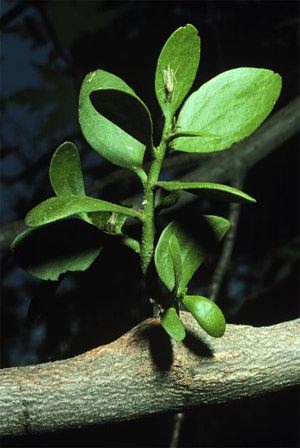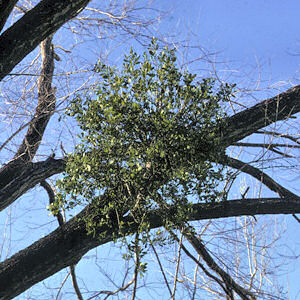So I've had unicellular parasites, metazoan parasites, even fungi parasites featured every week here. But there is one kind of parasite I haven't talked about: parasitic plants.
 The classic example of a parasitic plant is the ever-loved Christmas favorite: Mistletoe. "Mistletoe" is actually a fairly large group of hemi-parasitic plants in the order Santalales. They're called "hemi-parasites" because, in fact, they can produce some of their own food and nutrients, and aren't 100% dependent on their hosts for survival.
The classic example of a parasitic plant is the ever-loved Christmas favorite: Mistletoe. "Mistletoe" is actually a fairly large group of hemi-parasitic plants in the order Santalales. They're called "hemi-parasites" because, in fact, they can produce some of their own food and nutrients, and aren't 100% dependent on their hosts for survival.
Mistletoe is dependent upon birds to spread from host to host. The berries, while poisonous to people, are quite tasty to birds, who then spread the indigestible seeds via their feces onto new, unsuspecting plant hosts. Once on a new host, the seed sprouts and anchors its roots directly into its host's bark. Using its roots to gather water and nutrients, the mistletoe grows, eventually producing some of its own leaves for photosynthesis.
Amazingly, parasitism evolved nine times in the plant kingdom, five of which use the mistletoe-type system to steal nutrients from its host plant.
 What separates parasitic plants from the rest of the parasites is that they are considered keystone species. That's not to say other parasites aren't keystone species - I would bet that many are - scientists just haven't researched fully into the ecosystem effects of parasites. Only recently have they even been included in food webs, so there's a lot of work to be done.
What separates parasitic plants from the rest of the parasites is that they are considered keystone species. That's not to say other parasites aren't keystone species - I would bet that many are - scientists just haven't researched fully into the ecosystem effects of parasites. Only recently have they even been included in food webs, so there's a lot of work to be done.
Anyhow, a keystone species, for those who aren't aware of the term, is one that that has a 'disproportionate effect on its environment relative to its abundance.' In other words, it's a species which has a huge amount of influence compared to how common it is. The name refers to the central stone in a classic arch, which if removed, collapses the entire structure. The classic example of a keystone species is sea otters. Sea otters control the kelp ecosystem by being important biocontrols of sea urchin populations. If there are few otters, the urchins overpopulate, killing off massive amounts of kelp and the species that depend on them. Even small fluctuations in otter populations can have a drastic effect on kelp forests, hence their distinciton as keystone species.
 Parasitic plants are also considered keystone species - particularly mistletoe. By stealing nutrients from their hosts, they have a profound effect on the plant species dynamics where they live. Parasitc plant activity affects community structure, vegetation zonation and population dynamics in the areas they live. And it's not all negatives - juniper plants, for example, end up thriving in areas where they are parasitized by mistletoe because the parasite attracts birds which also spread the seeds of the juniper trees, allowing more plants to grow in spite of infections.
Parasitic plants are also considered keystone species - particularly mistletoe. By stealing nutrients from their hosts, they have a profound effect on the plant species dynamics where they live. Parasitc plant activity affects community structure, vegetation zonation and population dynamics in the areas they live. And it's not all negatives - juniper plants, for example, end up thriving in areas where they are parasitized by mistletoe because the parasite attracts birds which also spread the seeds of the juniper trees, allowing more plants to grow in spite of infections.
But above and beyond just affecting the plant community, mistletoes are key to the fauna where they live as well. A astounding variety of animals depend on the mistletoe for food and shelter, including a lot of birds and insects. In Australia, for example, mroe than 240 species of birds have been recorded nesting in mistletoe - more than 75% of the resident bird species.
 And, if mistletoes weren't cool enough because of their unique ecosystem-wide effects, they're also pretty important to people, too. Misteltoe derivatives are used to treat circulatory and respiratory system problems, and recent research is looking into misteltoe compounds to treat cancer, and the results are looking positive. Of course, more research would be needed to fully utilize it as an anti-cancer agent. They also are culturally important; the kissing thing is just one example of that. Mistletoe (Phoradendron flavescens) is also the state floral emblem for the state of Oklahoma, and has played a role in mythology and cultural traditions in a variety of peoples, from the Romans to the Celts and Druids and even Christians, where it was thought to once have been a tree which furnished the wood of the Cross.
And, if mistletoes weren't cool enough because of their unique ecosystem-wide effects, they're also pretty important to people, too. Misteltoe derivatives are used to treat circulatory and respiratory system problems, and recent research is looking into misteltoe compounds to treat cancer, and the results are looking positive. Of course, more research would be needed to fully utilize it as an anti-cancer agent. They also are culturally important; the kissing thing is just one example of that. Mistletoe (Phoradendron flavescens) is also the state floral emblem for the state of Oklahoma, and has played a role in mythology and cultural traditions in a variety of peoples, from the Romans to the Celts and Druids and even Christians, where it was thought to once have been a tree which furnished the wood of the Cross.
Anyhow, misteltoes are incredible in the sense that they have such a large impact on the world around them, from insects to people. If their pervasive, ecosystem-wide effects don't garnish them Sci-Fi Worthy status, I don't know what does.
